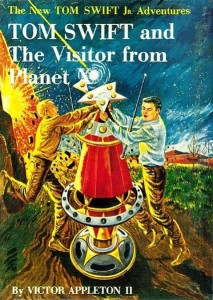When I was a young lad growing up in Cedar Rapids, Iowa in the mid-1960s, my Aunt Betty gave me a precious gift, a copy of Tom Swift and His Flying Lab by Victor Appleton II, ©1954. It was the first book in “the New Tom Swift Jr. Adventures” series which eventually included 33 novels.
 The series involves the adventures and inventions of an 18 year old engineer and scientist. Each book features a new invention and typical titles are Tom Swift and His Ultrasonic Cycloplane, or … and His Electronic Retroscope, or … and His Subocean Geotron. The series is a continuation of the previous Tom Swift (Senior) series that ran from 1910 to 1941.
The series involves the adventures and inventions of an 18 year old engineer and scientist. Each book features a new invention and typical titles are Tom Swift and His Ultrasonic Cycloplane, or … and His Electronic Retroscope, or … and His Subocean Geotron. The series is a continuation of the previous Tom Swift (Senior) series that ran from 1910 to 1941.
Aside from the blond main character with the crew cut, there was Tom’s sidekick Bud Barclay, Tom’s sister (and Bud’s girlfriend) Sandy, Tom’s girlfriend Phyllis Newton, Tom’s father Tom Sr., his mother Mary Nestor Swift, and the executive chef for Swift Enterprises, Charles “Chow” Winkler. I remember these characters as if I knew them as real people.
Story lines typically involved some trouble somewhere, like a kidnapping, a stolen invention, or some other evil being done in some exotic locale. Often one of the dastardly countries of Brungaria or Kranjovia was behind it all. Tom, fresh from some previous adventure, has just invented (or proceeds to invent) some gadget used to save the day.
We are not discussing superb literature here, admittedly. The characters were stereotypical and lacked depth. None of them changed or learned anything as a result of the conflicts they dealt with, either within any book or across the series. Tom himself had no character flaws whatsoever, other than paying insufficient attention to his very tolerant girlfriend. The writing style was amateurish. In an earlier post I already mentioned the occurrence of “Tom Swifties.” Any notion of realism was abandoned in these novels, from the basic premise of an 18 year old being the sole inventor of all the gadgets, to the implausibility of the inventions themselves, to the fact that one young man could be the hero in so many dangerous escapades.
I loved that series, and still do. I begged my parents for the next book I hadn’t read until I could afford to buy them myself. I thought about how cool it would be to have such machines and vehicles myself, or to be able to invent them. I compiled a personal library of about 2/3 of the series. Decades later, I found my mother had disposed of them, thinking I no longer wanted the set. That saddened me, but my brother scoured garage sales and helped me rebuild the collection. Thanks to him, I now have 18 volumes from that series, and 20 novels from the earlier Tom Swift series.
It appears I’m not Tom Swift’s only admirer. There’s at least one website dedicated to the series, and an active discussion group.
None of Tom’s inventions mentioned were actually built. Indeed, most are impossible. But one of his gadgets, a mechanism never actually named or referred to, worked really well. That’s Tom’s Psycho-Subliminal Writer Inspiratron. The Tom Swift Jr. series, so loathed by librarians and English teachers, motivated my interest in engineering and in storytelling. It prompted me to read other things, better books, including the works of Jules Verne. Tom kindled an interest in adventure and traveling to distant places, and is a big part of why I joined the submarine service.
Please comment and let me know if Tom Swift also inspired you, or let me know what other books of your youth did. For now I’d like to say thanks for everything, Tom, especially your amazing Inspiratron. Sincerely,
Poseidon’s Scribe
